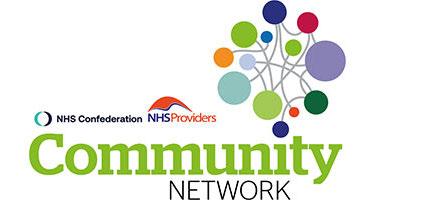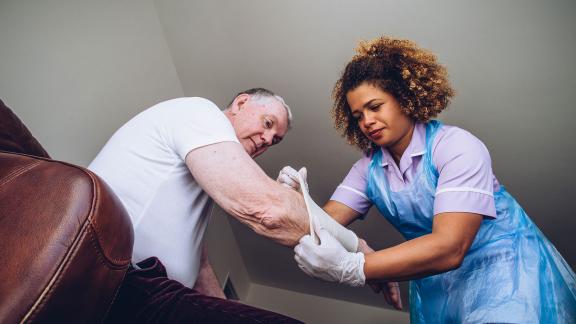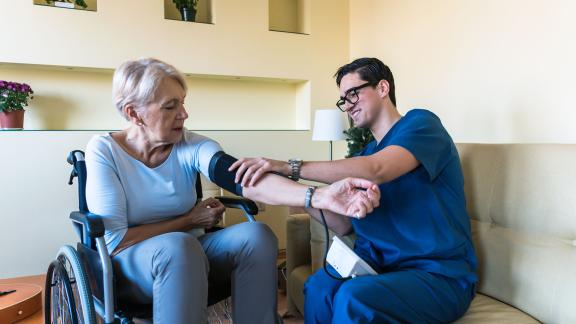Preventing unnecessary ambulance trips to A&E and hospital admissions in Walsall

Walsall Healthcare NHS Trust has embedded measures within community health services to prevent unnecessary ambulance trips to A&E and hospital admissions, including by developing a single point of access for urgent community response (UCR) services.
The case study is produced by the Community Network, which is hosted by the NHS Confederation and NHS Providers.
Key benefits and outcomes
- Best ambulance handover performance in the West Midlands for 18 of the last 19 months.
- Higher call volumes to the care navigation centre enabling more people to be diverted into community pathways.
- Lower admissions to hospital over the six months following an interventions by UCR teams.
About the organisation
Walsall Manor Hospital – part of Walsall Healthcare NHS Trust – delivers acute and community services for a population of around 270,000 across Walsall and the surrounding areas.
The hospital has approximately 550 acute beds and provides a range of community services, including community nursing, health visiting and musculoskeletal physiotherapy.
Walsall Manor Hospital is the lead provider for the Walsall Together place-based partnership with NHS, local authority and voluntary sector partners. It is part of the Black County ICS.
What the organisation faced
Walsall Manor Hospital has been on an improvement journey over recent years, having been in CQC special measures until 2019.
Like many others, the organisation has also experienced high levels of demand for ambulance services and urgent and emergency care (UEC), creating pressures on these services and pathways.
What the organisation did
The trust has adopted an organisation-wide approach to managing UEC pathways. This has supported Walsall Manor Hospital to maintain timely handovers of patients from ambulances.
There has been no single silver bullet. The impact of multiple improvement interventions along the UEC pathway, both in hospital (such as same-day emergency care) and community settings, has supported the handover of patients from ambulances and reduced pressures on the acute sector.
In the community sector, the team has been focusing on work to reduce unnecessary conveyances to hospital, to support people to return home from the emergency department (ED) and, where admission is unavoidable, to support complex discharges.
As part of this, the trust has launched an integrated assessment hub, which places community nurses at A&E to clinically assess patients. This means that patients who can receive the care they need at home are referred out of hospital and into a community pathway.
There has also been a focus on developing a strong community care navigation centre as a single point of access to UCR services, which have been expanded to operate from 8am to midnight (going over the 8am-8pm minimum outlined in national specifications).
Overcoming obstacles
Challenges securing recurrent funding present a barrier to driving forward this strategy around admission avoidance and prevention in the community. However, the team has overcome this by measuring outcomes and providing evidence that their work is bringing benefits to patients and the system. For instance, an evaluation showed that patients receiving a UCR intervention were less likely to attend ED in the following six months compared to a matched group.
A culture of seeking permission within the trust is identified as a challenge. Colleagues from other parts of the health and care system do not always understand what is possible in the community. The team has sought to address this by setting up small-scale pilots to demonstrate what can be achieved in community services and then sharing the impact with colleagues.
ICBs present new opportunities for collaboration, which can bring benefits to the quality of care delivered to patients. However, this shift towards a whole-system view of performance and progress can also produce new challenges.
Results and benefits
- Achieving the best ambulance handover performance in the West Midlands for 18 of the last 19 months, measured by the percentage of patients handed over from West Midlands Ambulance Service University NHS Foundation Trust to the trust within 30 minutes of arrival.
- The expansion of the care navigation centre has enabled the team to receive higher call volumes and divert more people into community pathways. The team received around 1,161 calls in September 2022, compared to around 500 in spring 2020.
- Interventions by UCR teams are having a positive impact on the long-term management of patients, with lower admissions to hospital over the six months following an interaction, compared to a matched cohort. This is due to UCR teams being well placed to refer on to other wraparound community services that can support someone’s longer-term health and wellbeing.
Takeaway tips
- Understand who is attending ED and what they require to be better supported in the community.
- Build on what is already in place and work with frontline colleagues to develop new initiatives.
- Explore ways to demonstrate outcomes and impact to support you to make the case for investment.
- Promote the importance of community services, and the work they do, to system partners.
- Discuss risk sharing with system partners to ensure people feel confident working with new or expanded services.
Further information
For more information about this case study, contact Matthew Dodd, director of transformation at Walsall Together: matthew.dodd2@nhs.net




